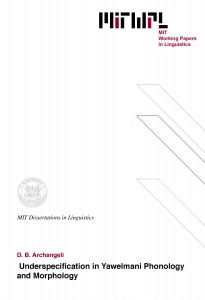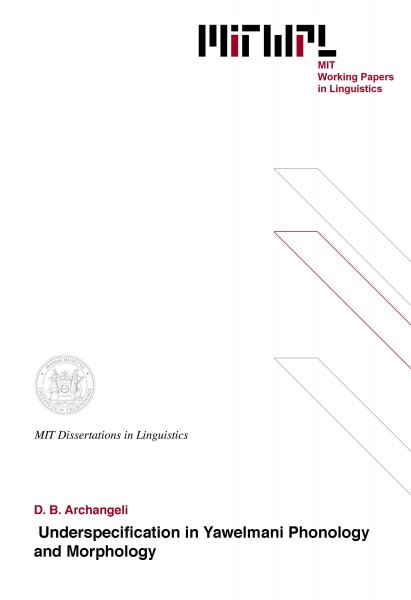Underspecification in Yawelmani Phonology and Morphology
D. B. Archangeli, 1984
This study of Yawelmani phonology and morphology provides insight into the types of phonological representations and rules permitted by Universal Grammar.
Generalizations about the sound pattern of a language which can be expressed by rule are omitted from underlying representation in all brands of phonological theory. Proposed here is a theory of underspecification which exploits this concept and so allows for simplification of both representations and rules. Underlying representations contain only the information that is absolutely necessary to distinguish between representations. Any information that is predictable, i.e. derivable by rule, is unspecified. “Information” here refers to all types of phonological characteristics, stress, syllable structure, templates, phonemes, and features. It is argued that the redundancy rules, i.e. the rules that fill in the unspecified values, are a combination of universal rules (which are cost-free) and learned rules (which are costly). In other words, what is unspecified in any given language is determined by both the details of that language and the principles of Universal Grammar. These redundancy rules are universally ordered late, with two exceptions. Earlier ordering of some rule can be provided by principles of Universal Grammar, i.e. intrinsic ordering (which is cost-free) or can be learned, i.e. extrinsic ordering (which must have clear motivation and is costly).
Non-linear representations figure centrally in this analysis of Yawelmani. It is shown that Yawelmani has a template-supplying morphology in both the verbal and noun systems (similar to certain Semitic languages). Interestingly, in most cases, the templates are supplied by affixes, and are meaningless without the affix. Besides the morphologically supplied syllabic templates, there is motivation for seven planes in the representation: The syllabification process consists of a syllable plane and a syncope tree plane; stress trees and a stress grid provide two more planes; vowels and consonant melodies constitute the fifth and sixth planes. The glottal stop in certain morphemes is on a plane of its own: A seventh plane. Evidence reveals that the harmonizing feature and the conditioning feature are on a single plane, but in separate matrices. The matrix of the harmonizing feature spreads on the single plane to the conditioning matrices.
Thesis supervisor: Morris Halle, Institute Professor
| 1 | Introduction | 11 | ||
| 1.1 | Surface and underlying representations | 13 | ||
| 1.2 | Rule interaction | 25 | ||
| 1.3 | A historical perspective | 27 | ||
| 1.4 | A comparison | 29 | ||
| Appendix: Rule writing notation | 34 | |||
| 2 | Underspecification | 35 | ||
| 2.1 | Full, partial, and underspecification | 38 | ||
| 2.1.1 | Full specification | 39 | ||
| 2.1.2 | Partial specification | 40 | ||
| 2.1.3 | Underspecification | 41 | ||
| 2.2 | The alphabet | 43 | ||
| 2.2.1 | The rules | 46 | ||
| 2.2.2 | The matrix | 48 | ||
| 2.2.3 | Latvian raising | 51 | ||
| 2.3 | Underspecification theory | 55 | ||
| 2.3.1 | Default rules and complement rules | 57 | ||
| 2.3.2 | Redundancy rules | 60 | ||
| 2.3.3 | Complement rule formation | 64 | ||
| 2.4 | Yawelmani vowels | 72 | ||
| 2.4.1 | Underlying representation | 73 | ||
| 2.4.2 | Vowel harmony in brief | 78 | ||
| 2.4.3 | The redundancy-rule ordering constraint | 83 | ||
| 2.4.4 | Two other rules—epenthesis and dissimilation | 94 | ||
| 2.5 | Yawelmani consonants | 96 | ||
| 2.5.1 | Sonorants | 99 | ||
| 2.5.2 | Obstruents, nasals and laterals | 104 | ||
| 2.5.3 | Underlying representations and redundancy rules for consonants | 107 | ||
| 2.6 | A comparison with markedness theory | 111 | ||
| Appendix: Default rules and the Yawelmani vowel alphabet | 115 | |||
| 3 | Phonology | 117 | ||
| 3.1 | Vowel quality | 120 | ||
| 3.1.1 | Spread vs. copy | 121 | ||
| 3.1.1.1 | Yawelmani lowering | 125 | ||
| 3.1.1.2 | Gashowu lowering | 130 | ||
| 3.1.1.3 | Discussion | 132 | ||
| 3.1.2 | Uniplanar, biplanar and coplanar representations | 136 | ||
| 3.1.2.1 | Yawelmani harmony | 145 | ||
| 3.1.2.2 | Gashowu harmony | 148 | ||
| 3.1.3 | Implications | 152 | ||
| 3.1.3.1 | The shared feature convention | 153 | ||
| 3.1.3.2 | The branching features constraint | 155 | ||
| 3.1.3.3 | The structure of the melody | 157 | ||
| 3.2 | Syllable structure | 162 | ||
| 3.2.1 | Underlying representations | 163 | ||
| 3.2.1.1 | Underlying syllable structure | 166 | ||
| 3.2.1.2 | Association to the template | 170 | ||
| 3.2.2 | Syllable structure | 172 | ||
| 3.2.3 | Core syllabification | 175 | ||
| 3.2.4 | Syllabification rules | 178 | ||
| 3.2.4.1 | Shortening | 178 | ||
| 3.2.4.2 | Epenthesis | 182 | ||
| 3.2.4.3 | Syncope | 184 | ||
| 3.2.4.4 | Elision | 195 | ||
| 3.2.5 | Exceptions to rime formation/shortening | 198 | ||
| 3.2.5.1 | (i)(l)saa ‘causative-repetitive’ | 198 | ||
| 3.2.5.2 | Retardative activity | 201 | ||
| 3.2.5.3 | xoo ‘durative auxiliary’ | 203 | ||
| 3.2.6 | Exceptions to syncope | 206 | ||
| 3.2.6.1 | Three affixes not undergoing syncope | 207 | ||
| 3.2.6.2 | Case affixes | 208 | ||
| 3.2.6.3 | Optional deletion with (ʔ)ińay ‘contemporaneous gerundial’ | 209 | ||
| 3.3 | Stress | 211 | ||
| 3.3.1 | The representation of stress | 215 | ||
| 3.3.1.1 | Trees | 215 | ||
| 3.3.1.2 | Extrametricality | 218 | ||
| 3.3.2 | Yawelmani stress | 224 | ||
| 3.3.2.1 | Antepenultimate stress | 228 | ||
| 3.3.2.2 | Antepenultimate stress in nouns | 232 | ||
| 3.3.3 | Implications for stress theory | 237 | ||
| Appendix: Phonological rules of Yawelmani | 241 | |||
| 4 | Morphology | 245 | ||
| 4.1 | Template-supplying affixes | 250 | ||
| 4.1.1 | How to supply a template | 255 | ||
| 4.2 | The template | 261 | ||
| 4.2.1 | Neutral templates | 261 | ||
| 4.2.2 | Consonant and vowel melodies | 267 | ||
| 4.3 | Templates supplied to verbs by affixes | 271 | ||
| 4.3.1 | The six templates | 271 | ||
| 4.3.2 | The template pool | 276 | ||
| 4.3.3 | Additional support | 278 | ||
| 4.3.3.1 | Floating consonants | 279 | ||
| 4.3.3.2 | Floating glottal stop | 282 | ||
| 4.4 | Classification of verbal suffixes | 288 | ||
| 4.4.1 | Regular affixes | 289 | ||
| 4.4.2 | Template-supplying affixes | 292 | ||
| 4.4.3 | Template-supplying affixes with limited application | 294 | ||
| 4.4.4 | Template-supplying affixes with interesting associations | 296 | ||
| 4.4.4.1 | (i)(l)saa ‘causative-repetitive’ | 297 | ||
| 4.4.4.2 | d(aa) ‘repetitive’ | 299 | ||
| 4.4.4.3 | (ʔ)ii ‘causative’ | 301 | ||
| 4.4.4.4 | ʔaa ‘durative’ | 303 | ||
| 4.4.4.5 | (ʔ)ińay ‘contemporaneous gerundial’ | 308 | ||
| 4.5 | Classification of noun morphology | 309 | ||
| 4.5.1 | Case | 311 | ||
| 4.5.1.1 | CC]-final nouns | 311 | ||
| 4.5.1.2 | Cxx]-final nouns | 312 | ||
| 4.5.1.3 | CxC]-final nouns | 314 | ||
| 4.5.1.4 | xxC]-final nouns | 315 | ||
| 4.5.1.5 | Generalizations about case affixes | 315 | ||
| 4.5.2 | Template activity | 318 | ||
| 4.5.2.1 | Collapsing templates | 319 | ||
| 4.5.2.2 | Items undergoing template affixation | 326 | ||
| 4.5.3 | Floating segments | 329 | ||
| 4.5.3.1 | Floating [+G]—(ʔ)in ‘attributive’ | 329 | ||
| 4.5.3.2 | Floating [+G}—(ʔ)inin ‘resident of’ | 330 | ||
| 4.5.3.3 | Floating [+G]—(ʔ)aa ‘inchoative’ | 331 | ||
| 4.5.3.4 | CxCCC + (im)aam ‘decedent’ | 332 | ||
| 4.5.3.5 | (n)iit ‘decedent’ | 333 | ||
| 4.5.4 | Floating vowels | 334 | ||
| 4.5.4.1 | taa, yaa ‘causative inchoative’ | 336 | ||
| 4.5.4.2 | CxCCC ‘plural’ | 341 | ||
| 4.5.5 | Catalog of affixes on nouns | 343 | ||
| 4.5.5.1 | A catalog of N → V morphology | 343 | ||
| 4.5.5.2 | naa affixation | 345 | ||
| 4.5.5.3 | “∅” affix ‘characteristic activity’ | 345 | ||
| 4.5.5.4 | A catalog of N → N morphology | 346 | ||
| 4.6 | The template pool | 349 | ||
| 4.7 | Conclusion | 350 | ||

